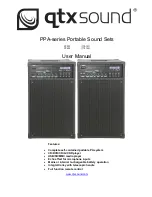
PortaNet User Manual
42 of 156
E 1 : M P L 3 - 1 2 8 - M N - 4 8
When you press the BOOK key you will only be shown those entries that
are relevant to the NET that is currently activated. So when NET = ISDN,
you will only be able to browse previously stored ISDN entries, just as
when NET = IP you will only be able to select from relevant IP addresses.
VII.12
Incoming calls
The incoming calls can be connected on line 1 or line 2. It is worth mentioning
here that each line has a different application and, for example, over IP, there
are different configuration options (line 2 only encodes G722). Line 1 will be the
main program and line 2 the coordination or TalkBack program.
Next follows some recommendations to avoid confusion when controlling the
lines:
VII.12.1
Receiving ISDN calls
Compatibility:
it is compatible with any ISDN audio codec with the same
compression modes.
Compression algorithms:
There are no restrictions regarding the available
compression modes in any line. Encoder and decoder can work in different
modes independently.
Automatic and manual answer:
Incoming calls can be answered
automatically or manually depending on the menu option ‘ANS’. If the ‘ANS’
mode is set to manual, the corresponding CALL key must be pressed to accept
the call and connect to it.
-
Automatic answer
The call is picked up automatically.
-
Manual answer
In this mode, the unit will warn about the incoming call
by blinking the LED of the corresponding line. To pick up
the call, press the corresponding CALL key.
Mapping Incoming calls:
With the LNUM (local number) option it is possible to
assign a different number to each of the lines available on the basic rate ISDN
interface. In this way we can automatically map incoming calls to each line, and
each line will only respond to those calls which were made to this local number.
When the local number is programmed the unit only detects as an incoming call
Summary of Contents for PortaNet
Page 77: ...PortaNet User Manual 77 of 156 ...
Page 135: ...PortaNet User Manual 135 of 156 ...
















































